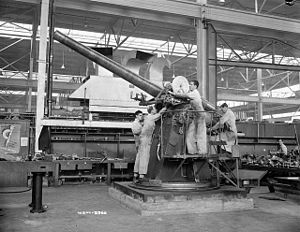Cannon 102/45
| Cannon 102/45 | |
|---|---|
 The Cannon 102/45 was a licensed copy of the QF 4 inch Mk V naval gun shown here. | |
| Type | Naval gun Anti-aircraft gun Coastal artillery |
| Place of origin | United Kingdom |
| Service history | |
| In service | 1917-1945 |
| Used by | Italy |
| Wars | World War I World War II |
| Production history | |
| Designed | 1913 |
| Manufacturer | Ansaldo |
| Produced | 1917 |
| Variants | Schneider-Armstrong Model 1917 Schneider-Armstrong Model 1919 Schneider-Canet Model 1917 |
| Specifications | |
| Mass | 2,327 kilograms (5,130 lb) |
| Length | 4.7 meters (15 ft 5 in) |
| Barrel length | 4.57 meters (15 ft 0 in) |
| Shell weight | 13.7–16 kilograms (30–35 lb) |
| Caliber | 102 millimeters (4.0 in) 45 Caliber |
| Breech | Horizontal or vertical sliding breech block |
| Elevation | See Table |
| Traverse | -360° |
| Rate of fire | 7 rpm |
| Muzzle velocity | Schneider-Armstrong: 850 m/s (2,800 ft/s) Schneider-Canet: 888 m/s (2,910 ft/s)[1] |
| Maximum firing range | Horizontal: 15 kilometres (9.3 mi) at +35° AA: 8,000 m (26,000 ft) |
The Cannon 102/45 was a naval gun of the Italian Navy in World War II, which was later modified for shore based anti-aircraft and coastal artillery roles.
History
[edit]During World War I the United Kingdom delivered a QF 4 inch Mk V naval gun, serial No.974 to Italy to act as a template for licensed production by the Ansaldo Company. The Mark V was constructed of a tapered inner A tube, A tube, taper wound wire, full-length jacket and breech ring.[2] It had either a horizontal or vertical sliding breech block, with semi-automatic action and used fixed quick-fire ammunition. There were three models produced: Schneider-Armstrong Model 1917, Schneider-Armstrong Model 1919, and Schneider-Canet Model 1917; each with differing mounts and elevations. Overall the 102/45 was considered a successful design and it was widely used on destroyers of the Italian Navy before and during World War II. The exception being the Schneider-Armstrong Model 1919 which was an unsatisfactory twin mount with both guns sharing a common cradle. The Model 1919 was later replaced by single mounts during the war.[3] The 102/45 was in the process of being replaced by the Cannon 120/45 and 120/50 when World War II began. Starting in 1937 guns that were removed from ships were mounted on new dual-purpose shore mounts and used as anti-aircraft guns and coastal artillery until retired in 1945.
Interesting facts
[edit]- The reported muzzle velocities for the Schneider-Armstrong 850 m/s (2,800 ft/s) and Schneider-Canet 888 m/s (2,910 ft/s) are slightly different.
- The muzzle velocities of the 102/45 are higher than the Mk V 719 m/s (2,360 ft/s) implying greater working pressure.[4] What effect this had on barrel life and accuracy is unknown.
- The rates of fire for the 102/45 (7 rpm) and Mk V (8-10 rpm) are different.[5]
Types
[edit]| Mounts | Model | Weight | Elevation | Naval Classes |
| Single Open Mount | Schneider-Armstrong
Model 1917 |
4,600 kg | -5°/+35° | Generali-class, Palestro-class, La Masa class, Giuseppe Sirtori |
| Schneider-Canet Model 1917 | -5°/+30° | Mirabello-class, Alessandro Poerio class | ||
| Twin Mount | Schneider-Armstrong Model 1919 | 10,000 kg | -5°/+35° | Curtatone-class |
| Single Mount
Dual-purpose |
Model 1936 | -5°/+85° | Anti-aircraft and Coastal artillery |
Notes
[edit]- ^ Friedman, Norman (2011-01-01). Naval weapons of World War One. Seaforth. ISBN 9781848321007. OCLC 786178793.
- ^ DiGiulian, Tony. "Italy 102 mm/45 (4") S-A Models 1917 and 1919 and S-C Model 1917 - NavWeaps". www.navweaps.com. Retrieved 2017-03-05.
- ^ Friedman, Norman (2011-01-01). Naval weapons of World War One. Seaforth. p. 339. ISBN 9781848321007. OCLC 786178793.
- ^ M., Campbell, N. J. (2002-01-01). Naval weapons of World War Two. Naval Institute Press. pp. 241–242. ISBN 0870214594. OCLC 51995246.
{{cite book}}: CS1 maint: multiple names: authors list (link) - ^ Fraccaroli, Aldo (1974). Italian Warships of World War II. London: Ian Allan Publishing. p. 189.
Bibliography
[edit]- Campbell, John (1985). Naval Weapons of World War Two. Naval Institute Press. ISBN 0-87021-459-4.
- Fraccaroli, Aldo (1974). Italian Warships of World War II. London, England: Ian Allan Publishing. OCLC 834485650.
- Friedman, Norman (2011). Naval Weapons of World War One. Barnsley, South Yorkshire, UK: Seaforth. ISBN 978-1-84832-100-7.
